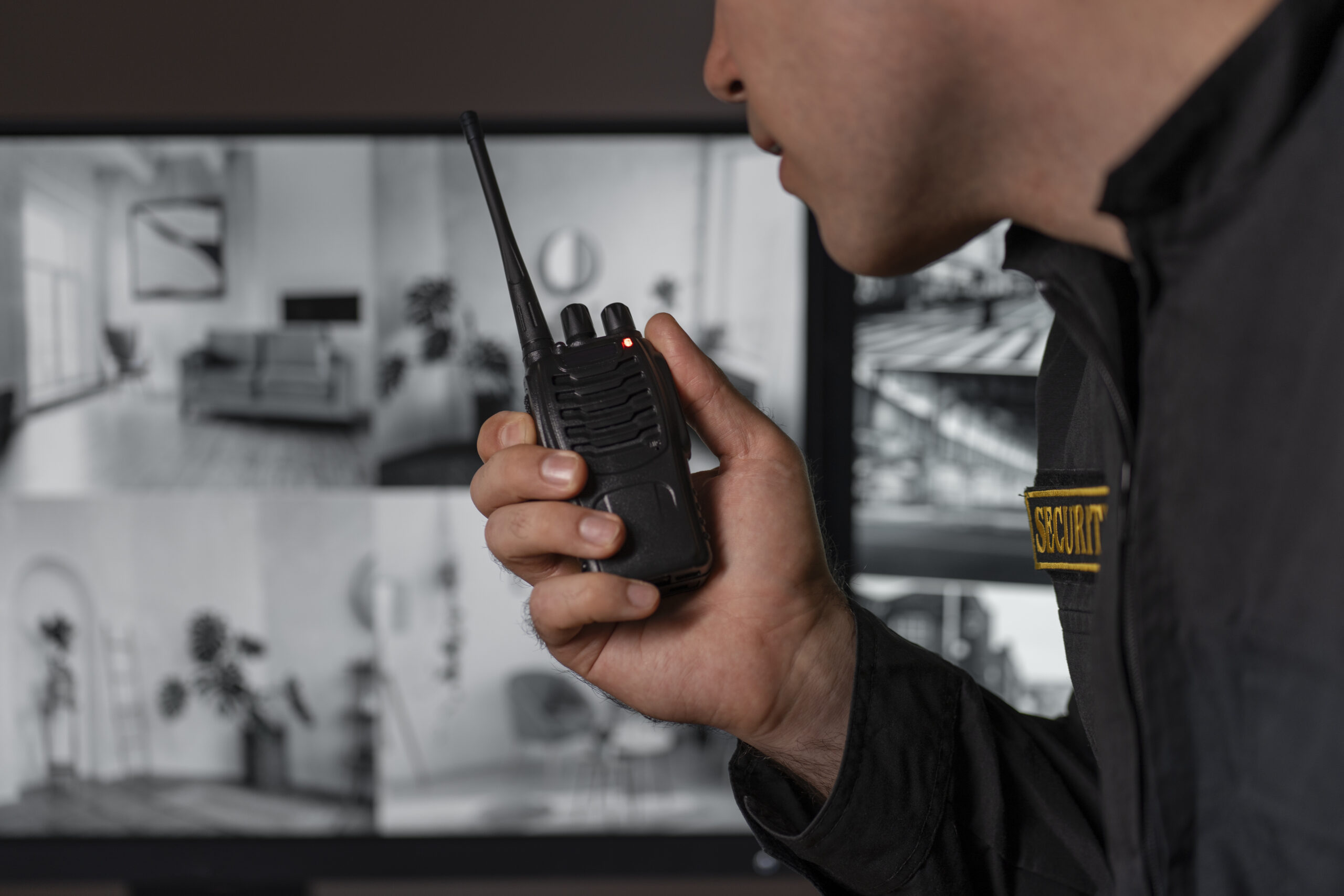Monitoring Response Time: Fast & Reliable

Many homeowners wonder how quickly help will come when their alarm goes off. They’re not alone—63% of American homeowners feel safer with faster emergency response times [1]. This concern is important, as quick responses can make a difference in emergencies. Understanding security monitoring response times can help everyone choose the right protection for their homes and families. Readers can learn more about how to ensure they get the best response times and the peace of mind they deserve. Keep reading to uncover essential insights into security monitoring and response times.
Key Takeaway
- Response time is the duration between an alarm sounding and help arriving.
- Quicker response times can stop serious incidents and boost overall safety.
- Knowing what influences response time helps in selecting the best security system.
Understanding Security Monitoring Response Time
Response time is the time it takes for help to get there after an alarm goes off. It starts when something triggers the alarm, like a door sensor detecting movement. The monitoring center must act fast to send help. The speed of that response can make a big difference. If help arrives quickly, it might stop a theft or keep someone safe.
Homeowners and business owners should ask, “How fast can I get help if something goes wrong?” This question makes people think about how reliable their security systems are. A faster response time gives a better chance to avoid bad situations.
Understanding response times helps people make smart choices about their safety. It also pushes them to look for security systems that respond quickly.
Importance of Response Time
Response time matters a lot because it can mean catching a thief or losing valuable things. When an alarm sounds, the monitoring team needs to act fast. If they take too long, the chance of getting back stolen items goes down a lot. Research shows that only 13.5% of burglaries are solved, highlighting the need for quick response times to protect what people own [1].
Every second counts in an emergency. The sooner help arrives, the better the result can be. For instance, if a monitoring center responds within 30 seconds, police can get there in time to catch a burglar. But if it takes 10 minutes or more, the thief might be long gone.
People who buy security systems should think about response times as part of their safety plan. Knowing that a system can respond quickly gives peace of mind. It reassures homeowners that they are protecting their families and their belongings.
Factors Affecting Response Time
Many things can cause delays in response time. Understanding these issues can help make security better. Here are some key points to consider:
- Operational Bottlenecks: These are problems that slow down how quickly help can be sent. This might happen if procedures are unclear or if there aren’t enough staff members to manage alarms quickly. If operators aren’t sure what to do, they can waste valuable time.
- System Bottlenecks: Sometimes, technical problems can cause delays. This might be due to old equipment or bad communication between systems. If the technology doesn’t work well, it can stop operators from acting quickly.
Fixing these problems can lead to faster response times and better safety. Companies that monitor alarms should check their processes often. By finding and solving these issues, they can make sure help arrives as fast as possible. This not only improves safety but also builds trust with customers.
Best Practices for Improving Response Time
Organizations can take steps to improve how quickly they respond. Here are some helpful practices:
- Streamline Processes: Organizations should regularly look at their current procedures. By removing unnecessary steps, they can speed up response times. This ensures that every action is needed and done efficiently.
- Centralize Information: It’s important for operators to easily find all the information they need. When operators can quickly access the right data, they can act fast to help those in trouble. This means having all alarm details in one place.
- Training and Empowerment: Regular training keeps staff ready to make quick choices. When employees know the protocols well, they can act without hesitation. This cuts down the time it takes to respond to emergencies.
By using these strategies, organizations can make sure help arrives as quickly as possible. These practices not only improve response times but also make the security system work better overall.
Critical Incident Response Time (CIRT)
Critical Incident Response Time, or CIRT, is another key idea to understand. It measures how fast a team can start helping after a serious issue is found. CIRT focuses on how quickly help can be sent, which is important for reducing damage. For example, if a break-in happens, a quick CIRT can mean catching the intruder instead of losing valuable items [2].
Organizations should pay attention to CIRT when looking at their security measures. A shorter CIRT means they can react quickly in emergencies, helping to protect people and property. It’s not just about fixing problems; it’s about being ready to help when it really matters.
By improving CIRT, organizations show that they care about safety. This not only helps their operations but also makes customers feel secure, knowing they are in good hands.
How Technology Influences Response Time
Technology plays a big role in making security monitoring better. Advanced systems can automate alerts and provide real-time data. For example, some systems can connect directly with emergency services, allowing them to send help faster than old methods.
New technologies also help operators get clearer information about what is happening. When alarms go off, these systems show details like the location and type of alarm. This helps operators respond more effectively.
Plus, combining different data sources can make operations smoother. For instance, if a door sensor is triggered and a camera captures what’s happening, operators can understand the situation more quickly. This kind of teamwork makes it easier to respond fast and effectively.
Overall, using the latest technology can really improve response times. It’s crucial for security companies to invest in these tools to keep customers safe.
The Role of Training in Response Time
Training is very important for keeping response times low. When operators know what to do, they can react quickly to alarms. Regular training helps staff feel confident. This confidence allows them to make decisions without waiting for approval [3].
Operators who have practiced emergency responses are more likely to act clearly. They can assess situations quickly and communicate well with others involved. This can greatly cut down the time it takes to respond to emergencies.
Companies should make sure that training is ongoing and relevant. This keeps staff updated on the latest procedures and technologies. A well-trained team can make a big difference in a security situation. By investing in training, organizations show that they care about quick and effective responses.
Industry Variations in Response Time Expectations
Different industries have different expectations for response times. For example, banks need fast responses because the risk of losing money is high. They must act quickly to protect their assets and keep customers’ trust. In contrast, a retail store may focus more on customer safety and prioritize a quick response to possible threats.
Understanding these differences helps people know what to expect from their security systems. It also allows security companies to adjust their services to fit the needs of each industry.
By being aware of these variations, customers can make smart choices about which security systems will work for them. This knowledge helps ensure they pick a system that meets their specific safety needs.
Common Benchmarks for Acceptable Response Times

What is considered a good response time? Most security companies aim for response times under 60 seconds. This is a common standard for alarms. However, many home systems may take longer to respond. For homeowners, it’s important to look for systems that promise quick response times.
When shopping for security, potential customers should ask about average response times. They should also find out how those times can be improved. Understanding this information helps them choose a system that effectively protects their home or business.
A fast response time gives peace of mind. Knowing that help can come quickly makes people feel safer in their spaces. By choosing the right system, homeowners can improve their safety and security. These companies emphasize how important quick response times are in the security world.
FAQ
How long does it take for help to come when my alarm goes off?
Here’s what happens: Your alarm system sends an alarm signal to a monitoring center (called a central station). They’ll try to reach you through a phone call or text alerts first. If they can’t get you, they call law enforcement. How fast police response happens depends on your local public safety team and if you’ve had false alarms before. Many alarm companies work hard to make this process quick!
What happens when my sensors spot something?
Your control panel tells the monitoring center right away when motion sensors or door sensors notice something. Don’t worry – you usually have about 30-60 seconds (called an entry delay) to type your code on the touch screen before the alarm goes off. If you don’t turn it off, the team calls your cell phone. No answer? That’s when they make an emergency call for help.
How are new smart alarm systems different from old-school ones?
Think of smart alarm systems as your home’s brain! They let you watch what’s happening in real time through an indoor camera or video doorbell. Traditional companies focus on basic protection, but smart systems can do cool stuff like control smart lights too. Both kinds have a central station watching over your home, but smart systems let you check things from your phone.
Should I set up my security system myself or get professional help?
Let’s compare! DIY setup (best DIY systems) means you install everything yourself and save money on equipment cost. But if you choose professional help, security experts will make sure everything’s in the perfect spot – from your outdoor camera to glass break sensors and garage door alarms. Most DIY options today have high quality stuff and flexible autorenew packs instead of making you sign up for three years.
How much does it cost to have someone watch my home security?
The monitoring cost changes depending on which alarm companies you pick. Basic packages from some places cost about as much as a few pizzas each month. Want video security? That costs a bit more. Look for Black Friday deals to save money! You’ll need to buy a control panel and things like panic buttons or door sensors. Some have a fast protect promise, but always ask about equipment fees.
What makes my front door alarm respond faster or slower?
A few big things affect how quick your security alarms get help: whether you picked a DIY option or pro system, how good your cell phone signal is for alarm calls, and how many people are working at the central station. The best security systems use super reliable motion sensors and have backup ways to call for help. When alarm systems can always talk to monitoring centers, they work faster!
Final Thoughts
Understanding security monitoring response time is important for anyone wanting to protect their home or business. Faster response times can help stop serious incidents, and knowing what affects them can lead to better choices in security systems. By focusing on technology, training, and best practices, individuals and organizations can improve their safety. This awareness ensures that people feel more secure and confident in their spaces, making it easier to protect what matters most to them.
References
- https://rapidsos.com/top-3-reasons-why-security-alarm-responses-are-delayed-and-how-to-speed-them-up/
- https://www.threatintelligence.com/blog/critical-incident-response-time
- https://sureviewsystems.com/what-is-response-time-and-why-does-it-matter/